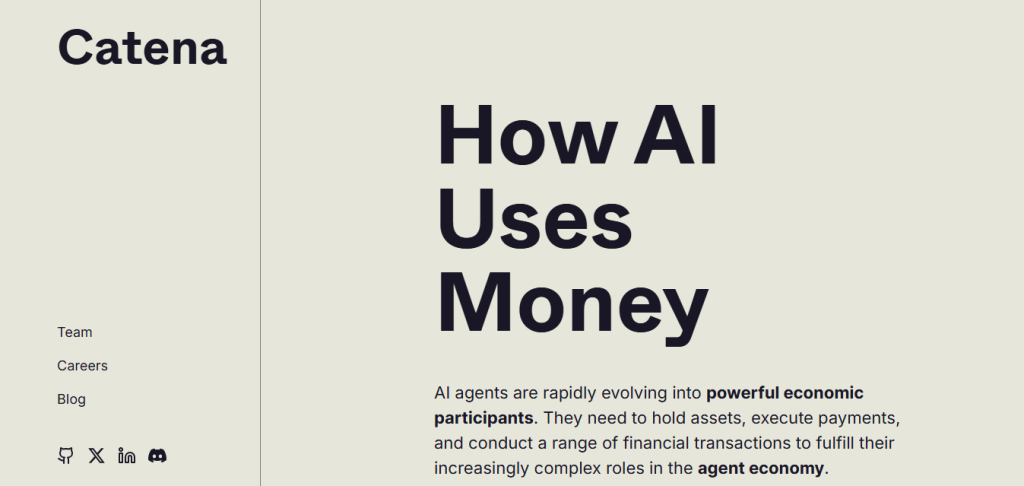Catena Labs Raises $18M to Revolutionize How AI Understands and Uses Capital
July 10, 2025
byFenoms Startup Research

Catena Labs, a cutting-edge platform at the intersection of AI and financial infrastructure, has successfully raised $18 million in a high-profile funding round. The round was backed by powerhouse investors including Breyer Capital, Circle Ventures, Coinbase, CoinFund, and Pillar VC, alongside tech visionaries such as Tom Brady, Balaji Srinivasan, Bradley Horowitz, and Kevin Lin.
Led by Sean Neville (co-founder of Circle) and Matt Venables, Catena Labs is on a mission to fundamentally redefine how artificial intelligence systems interact with capital - creating a programmable interface between money and machine intelligence.
A New Layer for Machine-Native Finance
The world has seen explosive growth in both AI capability and blockchain infrastructure, but rarely have they been integrated at a fundamental level. Catena Labs is changing that by building what it calls an “AI-native capital system” - infrastructure that enables autonomous agents to move, allocate, and reason about capital in real time.
Their product suite includes:
- Autonomous financial agents that can execute investment strategies based on real-world prompts
- Programmable capital environments that let AI reason about funding, costs, ROI, and impact
- Verification layers for AI alignment in financial transactions
- Toolkits for developers to embed financial reasoning into language models and agentic frameworks
This isn’t DeFi. It’s not fintech-as-usual. It’s a new category of infrastructure where capital becomes a computational primitive.
The Opportunity: Why It Matters Now
AI is evolving from a text-generation tool into a set of autonomous agents capable of acting in the world. But to do that effectively, these agents need financial literacy, access to programmable money, and infrastructure that speaks their language. Traditional APIs and banking rails don’t suffice.
Here’s the critical insight founders should internalize: the next platform wars won’t be fought on cloud or compute - they’ll be fought on capital intelligence layers. Catena Labs is positioning itself as the Stripe for AI-capable financial agents. Just like Stripe abstracted complexity from payments, Catena abstracts capital strategy for AI.
Most developers are focused on making AI smarter. But Catena is asking: How does AI spend? Invest? Save? Optimize across time? That’s the missing layer. And it’s one that could become indispensable as AI systems begin to interact more independently with real-world economies.
Backed by the Boldest Names in Tech
The investor list behind Catena Labs is a story in itself. Breyer Capital (early backer of Facebook), Coinbase, and CoinFund bring deep Web3 and infrastructure experience. Circle Ventures and Pillar VC lend credibility from the fintech and developer platform world.
But it’s the strategic angels - Balaji Srinivasan, Tom Brady, Bradley Horowitz, and others - that underscore how widely Catena’s vision resonates. This isn’t just a crypto startup. It’s a movement to create the rails for how autonomous software interfaces with value - and that excites a broad range of stakeholders.
AI x Capital: The Next Frontier of Machine Autonomy
The macro data points toward an inevitable collision of markets. According to PwC, AI is expected to contribute $15.7 trillion to the global economy by 2030. Meanwhile, CB Insights reports that startups building in agentic AI saw a 5x increase in venture funding over the last 18 months.
At the same time, the programmable finance sector (DeFi, on-chain automation, embedded fintech) is reaching new heights - with over $254 billion total value locked (TVL) as of June 2025.
But there’s still a gap. Most financial infrastructure is made for human interface layers. Catena Labs is one of the few players rearchitecting the stack for machine-native financial reasoning - with tools that make financial operations accessible to LLMs, autonomous agents, and orchestration layers.
This isn’t about disrupting banks. It’s about equipping intelligent agents with the tools to navigate economic logic - at machine speed, with auditability, and without human bottlenecks.
What’s Next for Catena Labs
With this $18M infusion, Catena Labs plans to:
- Expand its developer tools and SDKs for AI-native capital operations
- Open-source key components of its protocol to accelerate adoption
- Partner with leading LLM and agentic AI platforms
- Launch beta programs with hedge funds and algorithmic investors
- Contribute to emerging governance frameworks for autonomous capital
Co-founder Sean Neville noted that Catena isn’t just building another Web3 tool - it’s building foundational logic for how AI will participate in the world’s economies. “When software agents have the ability to move capital intelligently, that changes everything - from pricing risk to financing projects to negotiating contracts. We’re building the core infrastructure for that future,” Neville said.









